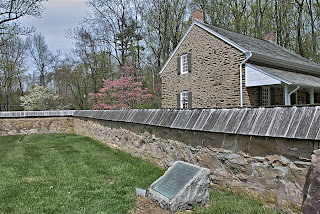Conventional understandings of the American Revolution often focus on a two-party dispute between the "Americans" and the "British." Among the colonists were diverse groups; one notable group were the Quakers. In New Jersey in particular, numerous Friends Meeting Houses were present. Here is the one at Stony Brook, which feature to an extent in accounts of the Battle of Princeton nearby, and a portion of its cemetery, featuring the DAR stone noting that Richard Stockton, a lawyer and signer of the Declaration of Independence, is buried on the grounds.
The Quakers officially adopted a neutral stance, although there were exceptions--not just Richard Stockton, but "The Fighting Quaker," Nathanael Greene. However, they were often viewed with suspicion, treated as spies or otherwise harassed by certain Patriots. Note George Washington's comments in a November, 1777 authorization regarding Army Clothing: "By virtue of the powers vested in me by the Honorable Congress I hereby Authorize ... to collect all such Blankets, Shoes, Stocking and other Clothing suitable to the use of the Army, within the Counties of ... in the State of Pennsylvania, as the Inhabitants can spare without greatly distressing their Families. In doing this you are to take care, that, the unfriendly Quakers and others notoriously disaffected to the cause of American Liberty do not escape your Vigilance."
One cannot help but think of the current debate over profiling of certain groups as security risks.

No comments:
Post a Comment